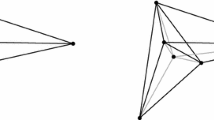Abstract
A polyhedral decomposition can be unambiguously described as the collection of four primitive elements (i.e., polyhedra, facets, edges, and vertices) plus their mutual adjacency relations. We consider here the problem of representing a specific kind of polyhedral decomposition, i.e., a tetrahedralization. We describe two different representations for a tetrahedralization. The first one can only model polyhedral decompositions with tetrahedral cells, while the second one is suitable for describing any partition of a volume into polyhedral cells with triangular facets. We present two sets of primitive Euler operators, which build and manipulate such representations while maintaining their topological integrity. The use of such operators is demonstrated in connection with two algorithms for building a Delaunay tetrahedralization, which show the different hedralization, which show the different uses of the two representations.
Similar content being viewed by others
References
Aho AF, Hoperoft JE, Ullman JD (1983) Data structures and algorithms. Addison Wesley, Reading
Avis D, Bhattacharya BK (1983) Algorithms for computingd-dimensional Voronoi diagrams and their duals. In: Preparata FP (ed) Advances in computing research, Vol 1. JAI Press, Greenwich, pp 159–180
Ansaldi S, De Floriani L, Falcidieno B (1985) Geometric modeling of solid object by using a face adjacency graph representation. Computer Graphics 19(3):131–139
Baumgardt MG (1972) Winged-edge polyhedron representation. Tech Rep CS-320, Stanford University
Boissonnat JD (1984) Geometric structures for three-dimensional shape representation. ACM Trans on Graphics 3(4):266–286
Boissonnat JD, Faugeras OD, Le Bras-Mehlman E (1988) Representing stereo data with Delaunay triangulation. Proc IEEE Robotics and Automation, Philadelphia
Bowyer A (1981) Computing Dirichlet tesselations. The Computer Journal 27(2):165–171
Bruzzone E, De Floriani L (1990) Algorithms for accessing and manipulating a 3D triangulation. Tech Rep Istituto Matematica Applicata, Genova (Italy)
Bruzzone E, De Floriani L, Puppo E (1989) Reconstructing three-dimensional shapes through Euler operators. Proc 5th International Conference on Image Analysis and Processing, Positano (Italy)
Chand DR, Kapur SS (1970) An algorithm for convex polytopes. Journal of the A.C.M. 17(1):77–86
De Floriani L (1987) Surface representation based on triangular grids. The Visual Computer 3(1):27–50
De Floriani L, Maulik A, Nagy G (1989) Manipulating a modular boundary model with a face-based structure. In: Wozny M, Turner J, Preiss K (ed) Geometric modeling for product engineering
Dobkin DP, Laszlo MJ (1989) Primitives for the manipulation of three-dimensional subdivisions. Algorithmica 4:3–32
Dwyer RA (1989) Higher-dimensional Voronoi diagrams in linear expected time. Proc 5th Symposium on Computational Geometry, Saarbrücken, pp 326–333
Greenberg MJ (1967) Lectures on algebraic topology. Benjamin, New York
Lawson CL, Properties ofn-dimensional triangulations. Computer Aided Geometric Design 3:231–246
Mantyla M (1988) An introduction to solid modeling. Computer Science Press
Preparata FP, Shamos MI (1985) Computational geometry: an introduction. Springer-Verlag, Tokyo Berlin Heidelberg New York
Requicha AAG (1981) Representation of rigid solids: theory, methods and systems. Comput Surv 12(4):437–464
Watson DF (1981) Computing then-dimensional Delaunay tesselation with applications to Voronoi polytopes. The Computer Journal 24:167–171
Weiler K (1985) Edge-based data structures for solid modeling in curved-surface environments. IEEE Comput Graph Appl 5(1):21–40
Weiler K (1986) Topological structures for geometric modeling. PhD Thesis, Rensselaer Polytecnic Institute, Troy, NY
Woo TC (1985) A combinatorial analysis of boundary data structure schemata. IEEE Comput Graph Appl 5(3):19–27
Author information
Authors and Affiliations
Rights and permissions
About this article
Cite this article
Bruzzone, E., De Floriani, L. Two data structures for building tetrahedralizations. The Visual Computer 6, 266–283 (1990). https://doi.org/10.1007/BF01900749
Issue Date:
DOI: https://doi.org/10.1007/BF01900749




